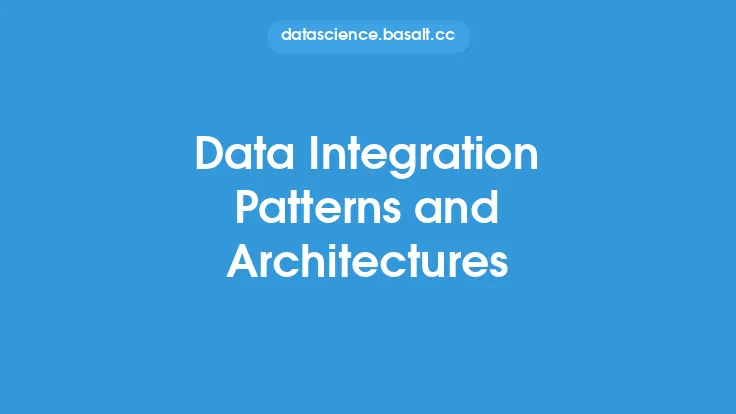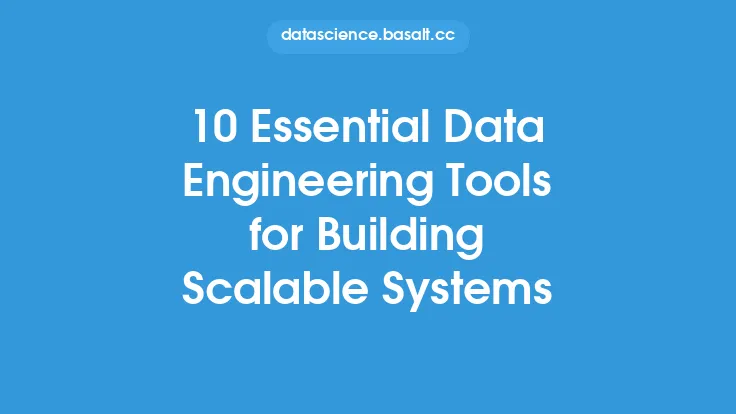In the realm of data engineering, designing and implementing a robust data architecture is crucial for organizations to manage and utilize their data effectively. A well-structured data architecture enables companies to extract insights, make informed decisions, and drive business growth. With the exponential increase in data volumes, varieties, and velocities, modern data systems require scalable, flexible, and efficient data architecture patterns. This article delves into the key data architecture patterns for modern data systems, exploring their characteristics, benefits, and applications.
Introduction to Data Architecture Patterns
Data architecture patterns provide a framework for designing and building data systems that can handle the complexities of modern data management. These patterns are based on proven principles and best practices, allowing organizations to create a robust and scalable data architecture. The primary goal of data architecture patterns is to provide a structured approach to data management, ensuring that data is properly ingested, processed, stored, and analyzed. By adopting these patterns, organizations can improve data quality, reduce data silos, and increase data accessibility.
Lambda Architecture Pattern
The Lambda Architecture pattern is a popular data architecture pattern that combines the benefits of batch and real-time processing. This pattern is designed to handle large volumes of data and provide fast data processing and analytics. The Lambda Architecture consists of three layers: batch, speed, and serving. The batch layer processes data in batches, providing a comprehensive view of the data. The speed layer processes data in real-time, enabling fast data processing and analytics. The serving layer provides a unified view of the data, allowing users to access and analyze the data. The Lambda Architecture pattern is ideal for applications that require both batch and real-time processing, such as data warehousing, business intelligence, and real-time analytics.
Kappa Architecture Pattern
The Kappa Architecture pattern is a simplified version of the Lambda Architecture pattern. It eliminates the need for a batch layer, relying solely on real-time processing. The Kappa Architecture pattern is designed for applications that require fast data processing and analytics, such as streaming data, IoT data, and real-time analytics. This pattern uses a single layer for data processing, providing a unified view of the data. The Kappa Architecture pattern is ideal for applications that require low-latency data processing and analytics, such as fraud detection, recommendation systems, and real-time personalization.
Microservices Architecture Pattern
The Microservices Architecture pattern is a software development approach that structures an application as a collection of small, independent services. In the context of data architecture, microservices provide a flexible and scalable approach to data management. Each microservice is responsible for a specific data-related task, such as data ingestion, data processing, or data storage. The Microservices Architecture pattern enables organizations to develop and deploy data services independently, reducing the complexity and risk associated with traditional monolithic architectures. This pattern is ideal for applications that require flexibility, scalability, and fault tolerance, such as data integration, data quality, and data governance.
Event-Driven Architecture Pattern
The Event-Driven Architecture pattern is a design approach that focuses on producing and handling events. In the context of data architecture, events represent changes to the data, such as data creation, update, or deletion. The Event-Driven Architecture pattern provides a scalable and flexible approach to data management, enabling organizations to respond to data changes in real-time. This pattern uses event producers, event brokers, and event consumers to handle events, providing a decoupled and asynchronous approach to data processing. The Event-Driven Architecture pattern is ideal for applications that require real-time data processing and analytics, such as streaming data, IoT data, and real-time analytics.
Data Lake Architecture Pattern
The Data Lake Architecture pattern is a design approach that stores raw, unprocessed data in a centralized repository. This pattern provides a scalable and flexible approach to data management, enabling organizations to store and process large volumes of data. The Data Lake Architecture pattern uses a flat architecture, eliminating the need for a traditional data warehouse. Instead, data is stored in its raw form, allowing users to access and analyze the data as needed. This pattern is ideal for applications that require data exploration, data discovery, and data science, such as data warehousing, business intelligence, and data analytics.
Data Warehouse Architecture Pattern
The Data Warehouse Architecture pattern is a traditional design approach that stores processed, structured data in a centralized repository. This pattern provides a scalable and flexible approach to data management, enabling organizations to store and analyze large volumes of data. The Data Warehouse Architecture pattern uses a layered architecture, consisting of a presentation layer, a business logic layer, and a data storage layer. This pattern is ideal for applications that require business intelligence, data analytics, and reporting, such as data warehousing, business intelligence, and data analytics.
Conclusion
In conclusion, data architecture patterns play a crucial role in designing and implementing modern data systems. By adopting these patterns, organizations can create a robust, scalable, and flexible data architecture that meets their business needs. The Lambda Architecture, Kappa Architecture, Microservices Architecture, Event-Driven Architecture, Data Lake Architecture, and Data Warehouse Architecture patterns provide a range of options for organizations to choose from, depending on their specific requirements. By understanding the characteristics, benefits, and applications of each pattern, organizations can make informed decisions about their data architecture, ensuring that they can extract insights, make informed decisions, and drive business growth.





